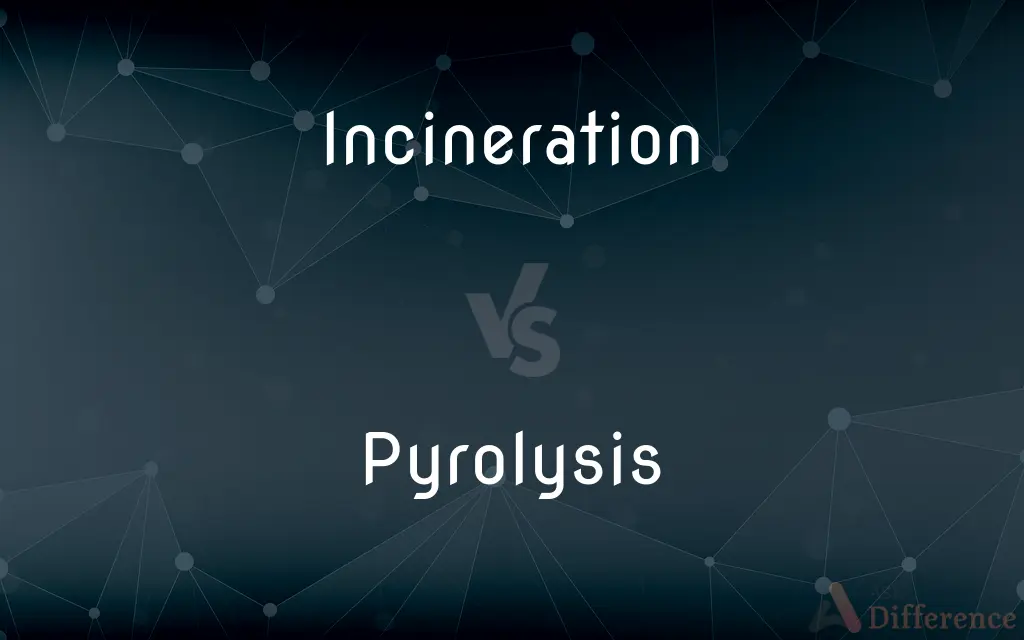Incineration vs. Pyrolysis — What's the Difference?
Edited by Tayyaba Rehman — By Fiza Rafique — Updated on April 14, 2024
Incineration involves burning waste to reduce its volume and produce energy, while pyrolysis decomposes organic material at high temperatures in the absence of oxygen, producing biochar, oils, and gases.

Difference Between Incineration and Pyrolysis
Table of Contents
ADVERTISEMENT
Key Differences
Incineration is a waste treatment process that involves burning organic materials to ash, significantly reducing waste volume and sometimes generating energy. On the other hand, pyrolysis heats organic materials in an oxygen-free environment, breaking down the material into various byproducts without combustion.
Incineration typically operates at higher temperatures (800°C to 1000°C) and directly involves oxygen, which leads to complete combustion of the material. Whereas pyrolysis occurs at lower temperatures (typically 400°C to 600°C) and avoids oxygen to prevent burning, leading to different end products such as char, oil, and syngas.
Incineration generally aims to minimize the volume of waste and can convert waste to energy, often in the form of electricity or heat, enhancing waste management efficiency. Conversely, pyrolysis is aimed more at producing usable byproducts and can be a source of renewable energy or chemical feedstocks, depending on the output.
Emissions from incineration include carbon dioxide and potentially harmful pollutants like dioxins and heavy metals, requiring significant air pollution controls. Pyrolysis, on the other hand, can be cleaner in terms of emissions but requires careful handling and processing of the produced gases and oils to prevent environmental contamination.
Incineration is widely used for municipal waste management and can handle a large volume of waste. Pyrolysis, while not as widely implemented on a large scale, is gaining attention for its ability to process specific types of waste, such as agricultural residues and plastics, into valuable products.
ADVERTISEMENT
Comparison Chart
Temperature
High (800°C to 1000°C)
Lower (400°C to 600°C)
Oxygen Requirement
Requires oxygen for combustion
Operates in the absence of oxygen
Primary Purpose
Reduce waste volume, energy generation
Produce biochar, oils, gases
Byproducts
Ash, heat, power
Char, bio-oil, syngas
Environmental Impact
High potential for pollutant emission
Lower emissions, but requires treatment
Compare with Definitions
Incineration
Often equipped with energy recovery installations to utilize the heat produced.
The heat from the incineration process was used to warm several public buildings.
Pyrolysis
A thermochemical decomposition of organic material at elevated temperatures in the absence of oxygen.
Pyrolysis is used to convert agricultural waste into biochar.
Incineration
Known for reducing the mass of waste by up to 80-85%.
Incineration made it possible to handle the increased waste during the festival.
Pyrolysis
Can serve as a precursor to gasification and combustion processes.
The char produced by pyrolysis can be further processed to enhance its energy content.
Incineration
Requires stringent air quality control measures to handle emissions.
The incineration plant was upgraded with advanced filters to reduce dioxin emissions.
Pyrolysis
Considered a form of recycling for plastics and other hydrocarbons.
Plastic waste undergoes pyrolysis to create usable fuel.
Incineration
Can handle a wide variety of waste including household, industrial, and hazardous.
Special incinerators are designated for the safe disposal of medical waste.
Pyrolysis
Produces three main products: pyrolysis oil, syngas, and char.
The syngas from pyrolysis can be used as a renewable energy source.
Incineration
A waste treatment process involving the combustion of organic substances contained in waste materials.
The city's incineration facility helps generate electricity while managing waste.
Pyrolysis
Offers an alternative to incineration for waste that might produce harmful emissions when burned.
Pyrolysis is preferred for treating waste tires to minimize releasing toxic substances.
Incineration
Incineration is a waste treatment process that involves the combustion of substances contained in waste materials. Industrial plants for waste incineration are commonly referred to as waste-to-energy facilities.
Pyrolysis
Pyrolysis is the thermal decomposition of materials at elevated temperatures in an inert atmosphere. It involves a change of chemical composition.
Incineration
To cause to burn to ashes.
Pyrolysis
Decomposition or transformation of a compound caused by heat.
Incineration
To burn completely.
Pyrolysis
The decomposition of a material or compound due to heat, in the absence of oxygen or other reagents.
Incineration
The act of incinerating, or the state of being incinerated; cremation.
Pyrolysis
Transformation of a substance produced by the action of heat
Incineration
The act of incinerating, or the state of being incinerated; cremation.
The phenix kind,Of whose incineration,There riseth a new creation.
Incineration
The act of burning something completely; reducing it to ashes
Common Curiosities
Is incineration or pyrolysis more cost-effective?
Incineration is currently more cost-effective and widely used globally due to its ability to handle large volumes of waste and generate energy, but pyrolysis offers potential for valuable byproducts and is gaining in technological investment.
Can both incineration and pyrolysis generate energy?
Yes, both processes can generate energy; incineration directly produces heat and sometimes electricity, while pyrolysis produces syngas and oils that can be converted into energy.
Which process is more environmentally friendly?
Pyrolysis is generally considered more environmentally friendly as it produces fewer pollutants compared to incineration, though it requires careful handling of byproducts.
What byproducts are formed from incineration?
Incineration primarily produces ash and flue gases, with the potential to capture heat for energy.
How does incineration impact air quality?
Incineration can impact air quality negatively if not properly managed, as it can emit dioxins, furans, and particulate matter.
Which process is more energy-efficient?
Pyrolysis can be more energy-efficient in terms of byproduct usability, though incineration is efficient at reducing waste volume and sometimes generating power.
What is the main difference between incineration and pyrolysis?
Incineration burns waste with oxygen to reduce volume and generate energy, whereas pyrolysis thermally decomposes waste without oxygen, producing various chemical byproducts.
What types of waste are best for pyrolysis?
Organic waste, especially plastics and biomass, are suitable for pyrolysis as they can be converted into valuable byproducts like bio-oil and char.
Can pyrolysis handle the same amount of waste as incineration?
Pyrolysis generally handles less volume than incineration and is more selective about the waste inputs to optimize byproduct quality.
How do the energy outputs of incineration and pyrolysis compare?
Incineration typically has a direct output of thermal energy that can be easily converted to electricity; pyrolysis produces energy carriers like syngas and oil, which require further processing to be used as fuel.
What are the byproducts of pyrolysis?
Pyrolysis produces bio-oil, syngas, and biochar, all of which have various industrial and energy uses.
Can pyrolysis help in carbon sequestration?
Yes, the biochar produced by pyrolysis can be used as a soil amendment, which helps sequester carbon and improve soil health.
Can incineration reduce the need for landfilling?
Yes, incineration significantly reduces the volume of waste, decreasing the dependence on landfills.
Is incineration safe for all types of waste?
Incineration can handle most types of waste, including hazardous materials, but it requires robust pollution control technologies to ensure safety.
Why isn't pyrolysis more widely used if it's environmentally friendly?
Pyrolysis technology is complex and often more expensive than incineration, limiting its widespread adoption despite its environmental benefits.
Share Your Discovery

Previous Comparison
Starfish vs. Octopus
Next Comparison
Information vs. IntelAuthor Spotlight
Written by
Fiza RafiqueFiza Rafique is a skilled content writer at AskDifference.com, where she meticulously refines and enhances written pieces. Drawing from her vast editorial expertise, Fiza ensures clarity, accuracy, and precision in every article. Passionate about language, she continually seeks to elevate the quality of content for readers worldwide.
Edited by
Tayyaba RehmanTayyaba Rehman is a distinguished writer, currently serving as a primary contributor to askdifference.com. As a researcher in semantics and etymology, Tayyaba's passion for the complexity of languages and their distinctions has found a perfect home on the platform. Tayyaba delves into the intricacies of language, distinguishing between commonly confused words and phrases, thereby providing clarity for readers worldwide.














































